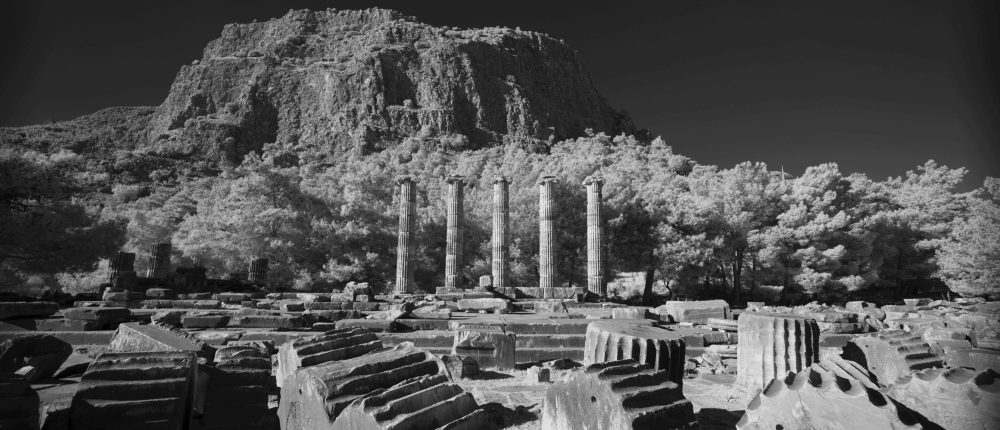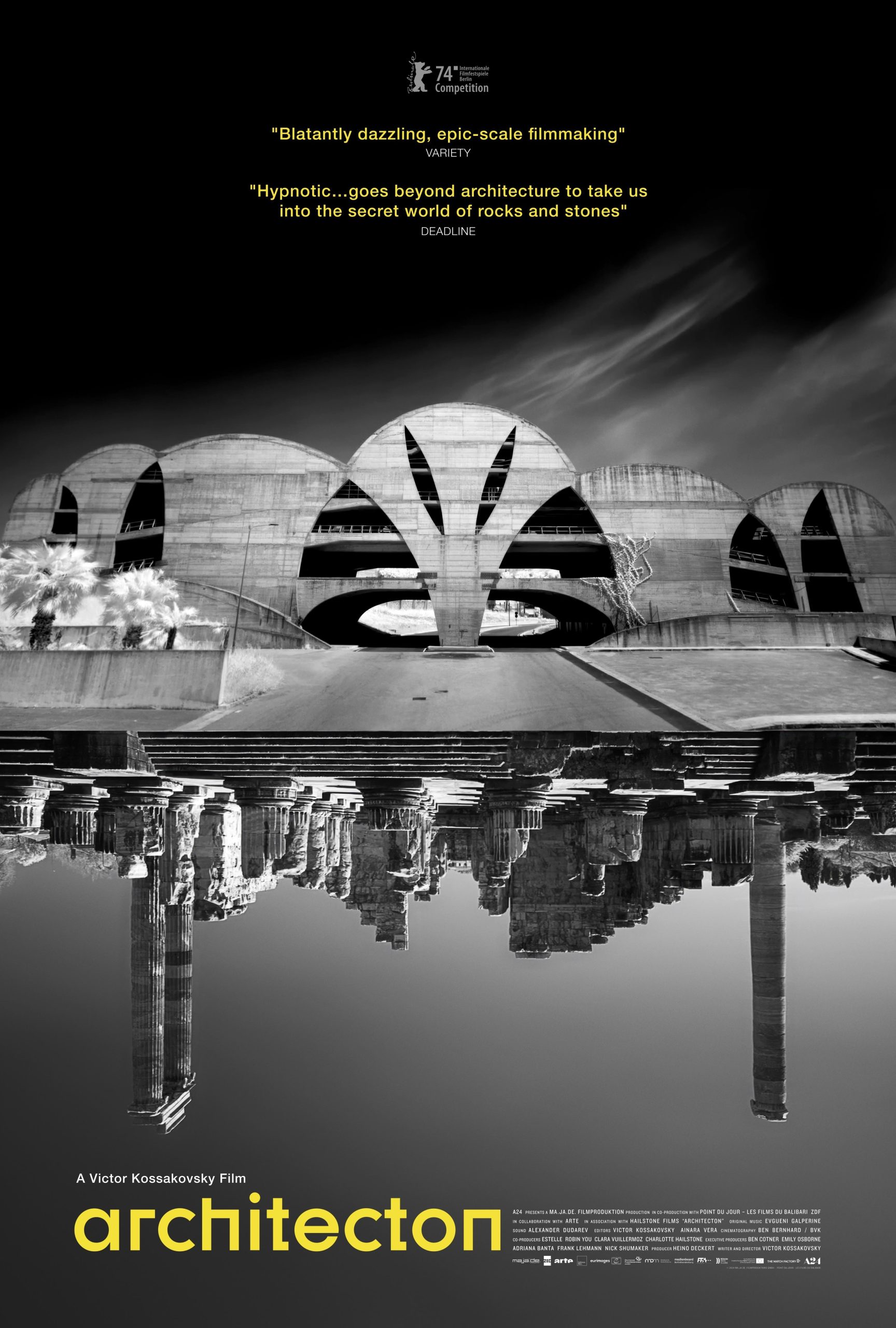
Architecton: A Tribute to Stone and a Rebuke of Concrete
One way to view the new film Architecton—first screened in Germany in October 2024—is as a love letter to stone, as it’s found worldwide in architecture across millennia. Written and directed by Russian documentary filmmaker Victor Kossakovsky and released by A24, this homage to the material takes us to exquisite ancient ruins filled with delicate carvings of column capitals; sprightly bounding segmental arches that appear to float on air (having survived thousands of years without collapse); massive monoliths in the Middle East, fallen like sleeping giants; skeletons of ancient temples, their fluted columns and entablatures still standing like the bones of long-dead creatures; and raw stone explosively thrust from the earth. Kossakovsky shoots many of these scenes with an infrared filter, making architecture and nature appear as if in a dream. And he manages to render stone as though it’s alive. There are long passages where we witness, in slow motion, stone avalanches in which the rocks seem to dance, moving in unison. Architecton makes these inanimate objects pulse with life. These images are mesmerizing, and in a film with scant dialogue, they deliver a penetrating message about the built world we’ve created.
Images of stone—either raw or carved with ancient care—seduce us, make us long for an architecture of permanence. In contrast to the solidity of this eternal material, contemporary construction is cheap, fleeting, flawed, ugly, wasteful. Our highly processed building materials—particularly concrete—compel us to often construct repellent environments unworthy of the term “architecture,” undeserving of preservation. In the context of this sobering state of affairs, the film’s protagonist—Milan-based architect Michele De Lucchi—undertakes a modest, contemplative project: the construction of a circle of stone in his own backyard. He works with two masons to shape the stones and carefully place them. (The architect comes off a bit like a grizzled wizard, with a long black overcoat and flowing beard.) The quiet work of De Lucchi and the masons contrasts with images of bleak concrete housing blocks, victims of war, natural disasters, or deterioration from expedient construction techniques preferred by spec builders and developers—and, one must add, abetted by uncritical or uncaring architects. Instead of a verbal testimonial about sustainable design and construction, renewable materials, and human-centered design, the film tells its story visually.
What emerges, as De Lucchi explained to me, “is a warning—one that resonates with many when faced with the consequences of our uncritical acceptance of the greed driving real estate speculation.”
In Architecton, concrete is the villain. After water, concrete is the second most-used substance on the planet. According to the journal Engineering Failure Analysis, each year we use three tons of concrete per person in the world—twice as much as all other construction materials combined. Concrete is the most-manufactured material in the world; more than 10 billion tons are consumed annually. Making a ton of concrete produces between 100 and 200 kilograms of greenhouse gas, and every year cement production accounts for 8% of all the carbon dioxide released. A midsized cement plant burns about 26 metric tons of coal per hour, 24 hours a day. And there aren’t comparable materials to take the place of concrete. “In many cases and for many applications, there’s currently no material that can replace it,” De Lucchi told me. “Although it’s extremely harmful, both in its production and use, it remains the cheapest and most convenient option.”
In one sequence, stone artist Nick Steur carefully constructs a stone sculpture, balancing rocks in a metal wire framework—communicating the idea that an architecture of stone might provide a stronger sense of equilibrium. The film then cuts to a shot of a construction robot defecating concrete in neat rows, building heedlessly without human intervention. It’s a soulless architecture, untouched by human hands, robbed of sacredness in the making. At that moment, Steur’s stone sculpture collapses.
Near the end of the film, there’s a dramatic transition where Kossakovsky and De Lucchi are resting beside the architect’s now-completed stone circle. The two begin to converse (Kossakovsky told me that this scene was completely improvised). The filmmaker asks the architect about people in the past who knew how to make buildings that lasted thousands of years, and why our buildings now seem to last only 40 or 50 years. “Why do we build ugly, boring buildings,” Kossakovsky asks of the architect, “if we know how to build beautiful ones?”
De Lucchi takes a long pause. He then confesses that his practice is currently designing a skyscraper for Milan, to be made primarily of concrete. “I’m ashamed of it,” De Lucchi stammers. It’ll be a concrete monolith, like everyone else does. “It’s just another box in the center of Milan. It’s not symbolic at all. It has no meaning. It doesn’t belong to nature.” The filmmaker asks the architect if we’ll ever “solve” the problem of concrete and find a substitute. De Lucchi responds that it’s possible, if we start using materials that give back to the earth instead of becoming just more landfill when they expire. “It comes back to life again,” De Lucchi says.
When I spoke with him, De Lucchi continued the thread: “We see the misery of our works in the destruction caused by earthquakes and wars, realizing that everything turns into piles of debris, very different from the ruins of ancient buildings created by our ancestors, which remain proud and full of dignity and beauty, bearing witness to extraordinary civilizations. We need a new idea of beauty.”
Kossakovsky shows apartment buildings destroyed in Turkish earthquakes bulldozed into landfills. “We turn mountains into cement, and we build buildings that last 40 years, on average,” states the filmmaker, “and cities that collapse in earthquakes. And then we make mountains of garbage from the remains of the concrete … and the cycle starts anew.”
While I agree with the sentiment, blaming a single material for a host of global architectural ills is simplistic. The crowning achievement of the nearly 2,000-year-old Pantheon in Rome is its poured-in-place, unreinforced concrete dome (the largest in the world), which has stood the test of time (obviously, it was not built with a 40-year horizon). Concrete as it is used today is a symptom of a much larger problem: it’s not the material itself, but its cheapening, the willingness of professionals in architecture, engineering, and construction to go along with the degradation, and a lack of focus in architecture on human- and planet-centered design.
With Architecton, Kossakovsky has created a visually sumptuous film that shows what architecture once was (noble) and what it has become (trash). De Lucchi is to be applauded for his candid, on-camera confession that he is part of a system of design, construction, and financing that delivers ugly, unsustainable built environments. Let’s work together to fix it.
All courtesy of A24.


